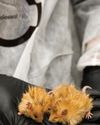Remember..... and Forget
Muse Science Magazine for Kids
|September 2023
THE SCIENCE OF MEMORY

All creatures, from the banana-buzzing fruit fly to the great blue whale, have some form of memory. Elephants remember the locations of distant watering holes. Mice remember how to find their way through laboratory mazes to food. And squirrels, who bury up to 10,000 nuts every year, remember-most of the time where they put them. Crows remember human faces. So, beware: If you're ever mean to a crow, they'll likely remember you.
Of all the memories in the animal kingdom, though, yours is especially impressive.

Each human brain contains about 90 billion neurons-and each of these can form more than a thousand connections with other neurons. Memories are stored in these connections, called synapses. This all adds up, scientists estimate, to more than 60 trillion connections, 2.5 million gigabytes (GB) of memory. (You've got your computer beat-a typical laptop may have eight GB of working memory plus another 256 GB of storage space.) That's right, your memory is huge. If it worked like a computer's hard drive, it would be large enough to store the information from five billion books, 670 million webpages, or 350 years' worth of television shows or films.

Short, Long, and In-Between
Scientists generally divide memory into two major types, short-term and long-term. All information-from the colors of the rainbow to your best friend's telephone number-first enter your memory through a holding pen called short-term memory. Short-term memory is just that, short. It only lasts around 30 seconds, and you can't put much in it. Studies show that short-term memory can only hold about seven pieces of information at a time.
Esta historia es de la edición September 2023 de Muse Science Magazine for Kids.
Suscríbete a Magzter GOLD para acceder a miles de historias premium seleccionadas y a más de 9000 revistas y periódicos.
¿Ya eres suscriptor? Iniciar sesión
MÁS HISTORIAS DE Muse Science Magazine for Kids

Muse Science Magazine for Kids
ANIMAL FIREFIGHTER TO THE RESCUE
Can animals help manage the risks of deadly wildfires?
3 mins
Muse July 2025: The Story Behind Wildfires

Muse Science Magazine for Kids
FIRE DANGER
WHY THE RISK OF WILDFIRES KEEPS GROWING
4 mins
Muse July 2025: The Story Behind Wildfires

Muse Science Magazine for Kids
The Miller NEW Normal
WHAT TODAY’S WILDFIRES TELL US ABOUT OUR FUTURE
8 mins
Muse July 2025: The Story Behind Wildfires

Muse Science Magazine for Kids
WOMEN AND FIREFIGHTING: A GOOD FIT
Jessica Gardetto is a firefighter. Her father was, too. “I grew up with my dad coming home smelling like wildfire and covered in soot,” she says.
1 min
Muse July 2025: The Story Behind Wildfires

Muse Science Magazine for Kids
What is happening on your fingertips when they get all wrinkly in a hot tub?
—Felix G., age 10, Montana
1 mins
Muse July 2025: The Story Behind Wildfires

Muse Science Magazine for Kids
WHEN the SMOKE CLEARS
THE LINGERING EFFECTS OF THE RECENT PACIFIC PALISADES AND ALTADENA EATON FIRES
6 mins
Muse July 2025: The Story Behind Wildfires

Muse Science Magazine for Kids
PICKING TEAMS
Keep it fair with a strategy that relies on geometry.
2 mins
Muse July 2025: The Story Behind Wildfires

Muse Science Magazine for Kids
SHAN CAMMACK
WILDLIFE BIOLOGIST AND FIRE SAFETY OFFICER
3 mins
Muse July 2025: The Story Behind Wildfires

Muse Science Magazine for Kids
Scientists Create Mice With Woolly Mammoth-Like Fur
RESEARCHERS AT A COMPANY IN TEXAS ARE WORKING TO CREATE A LIVING ANIMAL THAT RESEMBLES THE EXTINCT WOOLLY MAMMOTH. Recently, they produced mice with traits of the large mammal. The mice all have coats with mammoth-like fur, and some of the small mammals also have genes that help them store fat. Both features would help the animals survive in the cold Arctic, where the woolly mammoth once lived.
1 min
Muse July 2025: The Story Behind Wildfires

Muse Science Magazine for Kids
Cool Sunshade Added to the Nancy Roman Space Telescope
THE NANCY ROMAN SPACE TELESCOPE IS A NEW TELESCOPE THAT NASA IS BUILDING AND WILL LAUNCH INTO SPACE, LIKELY IN EARLY 2027.
1 min
Muse July 2025: The Story Behind Wildfires
Translate
Change font size

